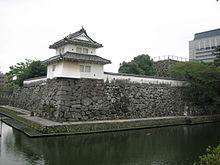

Yagura (櫓, 矢倉) is the Japanese word for "tower", "turret", "keep", or "scaffold". The word is most often seen in reference to structures in Japanese castle compounds but can be used in other situations as well. The bandstand tower erected for Bon Festival is often called a yagura, as are similar structures used in other festivals. Yagura-daiko (taiko drumming from atop a yagura) is a traditional part of professional sumo competitions.
Etymology
There were signs that the first written form of kanji was 櫓 during ancient periods, simply being a character representing a tower before being changed to 矢倉 – in which the former replaced the latter once again. The term originally derives from the use of fortress towers as high/tall or arrow (矢, ya) storehouses (倉, kura), and was thus originally written as 矢倉. The term was used for a collection of towers.
Today, modern towers such as skyscrapers or communications towers are almost exclusively referred to or named using the English-derived word tawā (タワー) and not yagura.
Castle towers
Castle towers varied widely in shape, size, and purpose. Many served as watchtowers, guardtowers, and for similar military purposes. Arrows were often stored there, with other equipment. As castles served as the luxurious homes of Japan's feudal lords (the daimyō), it was not uncommon for a castle to have an astronomy tower or a tower that provided a good vantage point for enjoying the natural beauty of the scenery.
Japan has rarely feared invasion or maintained border forts. However, it is likely that guardtowers or watchtowers would have been kept, outside of larger castle compounds, at times and places throughout its history.
References
- Kojien, Iwanami Shoten, Tokyo 1980
- Kenkyusha's New Japanese-English Dictionary, Kenkyusha Limited, Tokyo 1991, ISBN 4-7674-2015-6
- Shin-meikai-koku-jiten, Sanseido Co., Ltd, Tokyo 1974
- Official Grand Sumo homepage Archived 2007-08-11 at the Wayback Machine
Literature
- De Lange, William (2021). An Encyclopedia of Japanese Castles. Groningen: Toyo Press. pp. 600 pages. ISBN 978-9492722300.
- Turnbull, Stephen (2003). Japanese Castles 1540-1640. Oxford: Osprey Publishing.
- Motoo, Hinago (1986). Japanese Castles. Tokyo: Kodansha. p. 200 pages. ISBN 0-87011-766-1.
| Elements of Japanese architecture | ||||||||||
|---|---|---|---|---|---|---|---|---|---|---|
| Styles |
|  Model of Himeji Castle | ||||||||
| Types of building |
| |||||||||
| Roof styles | ||||||||||
| Structural and spatial | ||||||||||
| ||||||||||
| Rooms | ||||||||||
| Furnishings | ||||||||||
| Partitions | ||||||||||
| Outdoor objects | ||||||||||
| Measurements | ||||||||||
| Organizations | ||||||||||
| Related topics |
| |||||||||